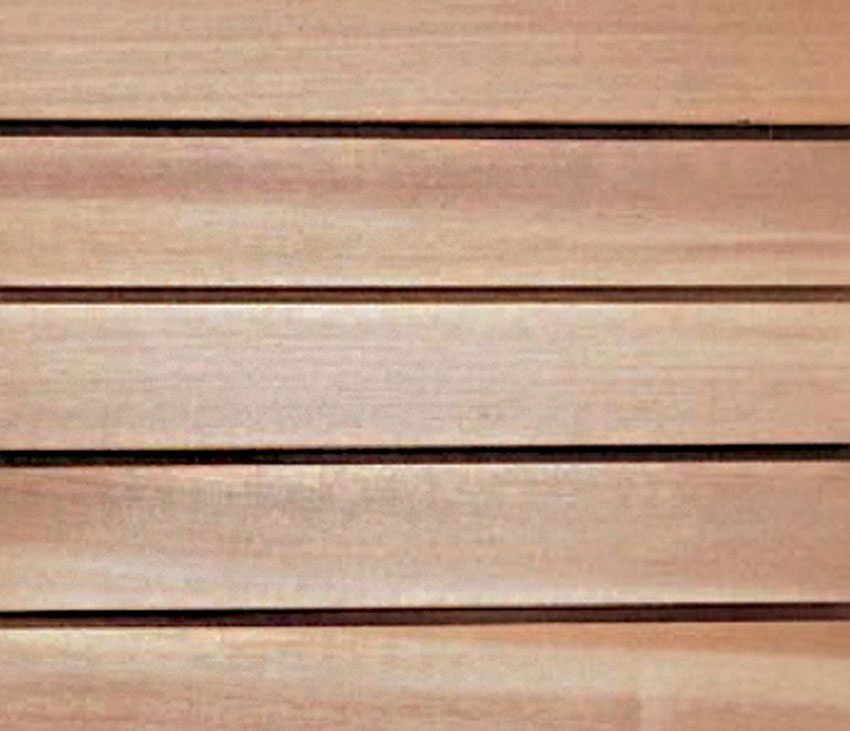Best Practices, Installation, and Finishing Options for Western Red Cedar
WRC Grades and Options
WRC is available in many grades and has various options based on quality and style. Major third-party certifiers, such as the International Standards Organization (ISO), Canadian Standards Association (CSA), and Sustainable Forestry Initiative (SFI), help architects easily compare WRC products and determine which will be the best for the project and the most sustainable for the environment.
Grade systems are determined and recognized by independent agencies so professionals can identify different appearance lumber grades as distinct from structural lumber grades for cedar. These grades include clear vertical grain heart, A, B, rustic, and various types of knotty.
Bevel Siding
Bevel siding is the most widely used cedar type. It is produced by resawing lumber at an angle to produce two pieces thicker on one edge than the other.
Clear Vertical Grain Heart
Clear vertical grain heart is the highest bevel siding grade. The word “heart” in the case of grading cedar refers to the inner wood in a tree as opposed to the narrow outer sapwood between the heartwood and the bark. It is sawn vertical grain (edge grain) and kiln dried. Pieces of the wood have a smooth face of decay-resistant heartwood and do not have inherent natural blemishes or characteristics that affect appearance or performance. These pieces also have excellent dimensional stability and hold finishes exceptionally well. Clear vertical grain heart and Grade A are mostly reversible to a resawn back.

Photo courtesy of Western Red Cedar Lumber Association
An example of clear vertical grain heart WRC, which does not have the knots that are so common to knotty cedar.
Grade A
A grade is a fine appearance grade that allows only slightly more growth characteristics than the clear vertical grain heart. Pieces are of mixed grain, vertical, and flat, and graded from the surfaced face. Typically, A grade cedar is sold with a percentage of B grade.
Rustic
Rustic grade siding is recommended for use as sidewall covering when the distinctive charm of a rustic saw-textured appearance is desired. This grade allows limited characteristics that do not detract from serviceability.
Knotty Cedar
Knots and other natural features define the visual characteristics of the WRC. Select knotty cedar materials show more of the knots on surface areas than other types of cedar products. All knots are sound and tight to ensure they remain intact and stable throughout the lifetime of the material. This cedar is rough surfaced, kiln dried, or unseasoned and smooth or with a resawn texture. Some companies may supply this grade of WRC with knots glued on the reverse face.
Of all the grades available, knotty cedar is growing in popularity for many reasons, including its high-performance capabilities and lower price point. When compared to other grades of cedar, knotty is the most cost-effective. All it takes is a quick square-footage price comparison for many to select knotty cedar over all the rest.

Photo courtesy of Western Red Cedar Lumber Association
Select knotty cedar is available in kiln dried or unseasoned and smooth or saw textured.
Knotty WRC, or Thuja plicata, is ideal for outdoor projects in many situations but especially in high-moisture conditions. Naturally occurring preservatives make it resistant to rot, decay, and insect attacks. A portion of the shipment may require job-site trimming to achieve a tight knot result.
Knotty cedar also provides many visual options from urbane and elegant to rustic and charming, making it an ideal building material for outdoor projects. The knots give it a more natural and earthy feel than clear cedar siding. Growing environmental awareness has certainly pushed its popularity, as has a trend to extend outdoor living spaces to blend in with and complement outdoor areas and natural landscaping.
Not only will it provide occupants and visitors with warm, inviting places, but architects and builders also love that it is light and easy to work with while still durable to withstand the test of time. The material comes in a variety of dimensions. It can be installed vertically, horizontally, or even diagonally, allowing the lines between the panels as well as the knots to create depth and a feeling of being in nature.
Knotty cedar is a material that is often imitated by other manmade materials. However, the aesthetics of natural knotty cedar can never be matched.
Shiplap, Tongue and Groove, and Boards
Other siding patterns include shiplap, tongue and groove, and boards for board and batten applications. The grade names discussed here are similar to the grades in bevel siding: clear heart, A, B, C, and D. Clear heart, A, and B grades are only available kiln dried. C and D grades may be available either kiln dried or unseasoned.
Shiplap patterns are produced and graded to the intended exposed face. Standard tongue-and-groove patterns are usually graded to the smooth face but in most cases are reversible to the resawn back. Boards are available in either S1S2E, meaning boards are surfaced or finished on one side and two edges, or S4S, meaning surfaced on all sides. Specify the desired texture for the graded face.
As with clear products, select knotty tongue and groove is usually graded to the smooth face, but in many cases it is reversible to the resawn back. With all tongue-and-groove and shiplap patterns, be sure to specify the desired edge detail (i.e., joint, fine line, flush joint, or wider reveal).
Boards refers to board and batten, trim, and fascia applications. Boards that are S1S2E are usually graded to the resawn side.
Knotty Timbers
Timbers are available in clear and knotty grades. If a clear look is desired, specify No. 2 clear and better. Knotty timbers are evaluated for appearance, meaning they have sound and tight knots as well as square edges. Structural grades are available and can be furnished by request. Timbers are usually supplied “rough” but may be supplied “surfaced” when requested.
Finishing Options
Unlike some other wood species, WRC is pitch and resin free. This means it is ideal for accepting and holding a wide range of wood finishes, including clear stains, semitransparent stains, solid stains, or paint to protect and preserve appearance and meet a variety of design needs for tonal or finished appearances. Regardless of the type or style of WRC specified, a critical element in creating a durable and attractive exterior siding is selecting the appropriate finish option. There are a variety of finishes available, including transparent, semitransparent, bleaching and weathering, solid stains, and paints.
Transparent
Transparent finishes allow the natural beauty of the wood to shine through while also keeping it protected from the elements. Transparent stains for exterior applications are available in solvent-borne oil formulas and latex formulas. Latex formulas do penetrate the surface and may form a film. Transparent, nonflexible, film-forming finishes such as lacquer, shellac, urethane, and varnish are not recommended for exterior use on cedar. Ultraviolet radiation can penetrate the transparent film and degrade the wood. Regardless of the number of coats, the finish will eventually become brittle, develop severe cracks, and then fail. Transparent finishes in exterior applications have very short service lives.
Semitransparent
Semitransparent stains may be latex or oil based. The semitransparent nature of the stain, due to its low solids content, does not block all ultraviolet radiation, and some will reach the wood’s surface. Latex stains do not penetrate the surface and are not as durable.
Two coats of penetrating oil-based stain on textured cedar will provide longer service life than one coat, but only if the wood will accept the second coat. Stir the stain thoroughly during application to prevent settling and color change. Avoid mixing different brands or batches of stain. Stain boards full length to avoid lap marks.
Latex semitransparent stains do not penetrate the wood surface, but they are easy to apply and less likely to form lap marks. These stains are film-forming and not as durable as oil-based stains.
Bleaching and Weathering
If a truly uniform grey appearance is desired, this effect can be achieved by the use of a commercially prepared bleaching or weathering product. This is essentially a water-repellent finish containing pigments and other additives, which is most effective on textured cedar. To maintain this look, the products may have to be reapplied periodically. Bleaching and weathering products are available in both oil and latex formulas. These water-repellent finishes contain pigments, and they are designed to mute the natural color range in the cedar and provide a more natural weathered look sooner than if the wood is left to weather naturally.
Uncoated, weathered WRC siding or trim can be restored to its original color by applying commercial products called cleaners, brighteners, or restorers. Although intended primarily for restoring horizontal wood surfaces such as decks, these products generally work almost as well on vertical surfaces. Some products are formulated with thickening agents to help the liquid cling better to vertical surfaces.
WRC still performs well in decking and siding applications, even if it is left unfinished to weather naturally. When WRC weathers naturally, it develops a silvery grey look and requires very little effort to maintain the finish. This could be an option for areas that are difficult to reach, such as siding projects on very tall buildings. Some also choose not to use any finishes to reduce any environmental impact from the chemicals applied during other finishing processes.
While natural weathering is a satisfactory finishing option, there are some long-term implications when not applying a finish to a cedar project. In very dry climates, WRC may not weather uniformly.
The weathered cedar can be restored to a state where it can be painted or stained. However, significantly more effort will be required to prepare the surface of the wood for coating.
Solid Stains
Solid-color stains are opaque finishes with fewer solids than paint. Available in a wide spectrum of hues, solid-color stains obscure the wood’s true color but allow some of the natural characteristics and texture of cedar to remain. Solid-color stains perform best on textured surfaces. They are nonpenetrating and, like paints, form a film. A stain-blocking primer should be applied first, followed by a 100 percent acrylic latex-based topcoat.
Solid-color stains may be applied to cedar by brush, roller, or pad. Brush application is usually the best. These stains act much like paint. One coat of solid-color stain is only marginally adequate on new wood. A prime coat with a topcoat will always provide better protection and longer service. The best performance can be obtained if the wood is primed and then given two coats of stain. Topcoats of 100 percent acrylic latex solid-color stains are generally superior to all others, especially when two coats are applied over a primer.
Unlike paint, a solid-color stain may leave lap marks. To prevent lap marks, follow the procedures suggested for semitransparent penetrating stains.
Factory finishing is available in many markets and is highly recommended. Factory-finish applications may be available with finish warranties.









